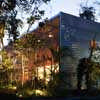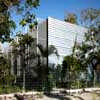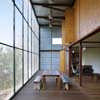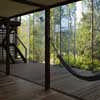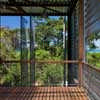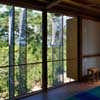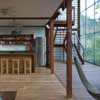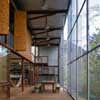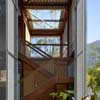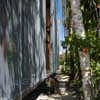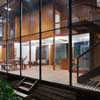São Paulo House, Photo, Architecture, Brazil Home Images, Architect, Property Project, Design
Casa RR, Brasil Property
Brazilian House, New Residential Building: Architecture design by Andrade Morettin Arquitetos
8 Sep 2008
R.R. House Brasil
Architects: Andrade Morettin Arquitetos
Photos: Nelson Kon
This São Paulo summer house is situated only a few meters from the sea, on the north coast of the State of São Paulo, a place with exuberant vegetation and hot humid climate.
the architects began the project with the idea of a big shelter, a “shell”, under which the actual living spaces would be located, protected from the intense sun and the frequent rains, however without blocking the permanent natural cross ventilation.
This roof at a height of six meters, with a surface of eighteen by eight meters, was built using a pre-fabricated timber structure with galvanized steel joints. The lateral and top faces are made of steel cladding with EPS filling.
On the two large facades of this São Paulo house, opening generously to the scenery, panels of glass fiber mosquito screens with PVC coating were installed, pivoting or sliding, with the intention of creating an external membrane, capable of keeping the insects out, without creating an obstacle for the ocean view and wind.
The whole structure is elevated 75cm above ground level, supported by concrete pillars cast on site. All other components used in the construction are pre-fabricated and were simply mounted in place on the construction site.
The adopted constructive system, besides reducing assembly time and errors, assured a dry construction site, with little generation of waste and low environmental impact.
Casa RR – Building Information
PROJECT: R.R. House
LOCATION: Itamambuca – SP, Brazil
SITE AREA: 500m2
TOTAL FLOOR AREA: 220 m2
PROJECT: 2006
COMPLETION: 2007
ARCHITECTS: Vinicius Andrade, Marcelo Morettin
COORDINATOR: Merten Nefs
PROJECT TEAM: Marcio Tanaka, Marcelo Maia Rosa, Marina Mermelstein, Renata Andrulis
PHOTOS: Nelson Kon
TIMBER STRUCTURE: Ita Construtora
CONTRACTOR: Vicente Ganzelevitch
FOUNDATION: Eng. Pedro Negri
ELECTRICS: Eng. Nilton Jose Maziero
SUPPLIERS: Masisa Brasil (OSB), Udinese-Papaiz (mosquito screens), Reka (lighting), Sicmol (glass tablets), Estrumec (cladding and metal frames)
PUBLICATIONS
_Azure Magazine: Summer Homes, jul/2008. Toronto, Canada
_www.architeria.eu, jul/2008. Poland
_D’a d’architectures 174, jun/2008. SEA/Innovapresse, France
_L’Arca No. 237, jun/2008. L’Arca Edizioni, Italy
_Architecture plus a+, may/2008. Inhouse Creative, Dubai, United Arab Emirates
_VIEW No. 95, may/2008. China Eastern Airlines, China
_Perspective, apr/2008. Perspective Ltd., China
_Casa Vogue 272, apr/2008. Carta Editorial, São Paulo, Brazil
_Arquitetura e Construo: Casas Contemporeas, jan/2008.
Editora Abril, São Paulo, Brazil
_NOZ No. 2 – Revista da PUC-RJ, 2008. Rio de Janeiro, Brazil
_Projeto Design No. 333, nov/2007. Arco, Brazil
_Arquitectura Viva 127, oct/2007. Spain
_Morar – Revista da Folha, oct/2007. Folha de São Paulo, Brazil
São Paulo House images / information from Andrade Morettin Arquitetos 090908
Andrade Morettin Associated Architects, São Paulo, Brasil
RR House
São Paulo – Brazil 2007
Introduction
In our practice we like to think of each project as being part of an ongoing search to develop appropriate solutions to our reality.
We also believe that architecture should be adapted carefully to its specific context: its beauty is a result of its capacity to respond to local conditions.
Given the socio-economic conditions of our country (vast territory and urgent shortage of low-cost housing), we wanted this project to serve as a prototype, a concept that could be reproduced.
Notion of Place
We see each project as a challenge not only to develop a design for a specific lot, but rather to point out solutions that could be applied to almost the entire national territory. In the next step, these solutions could be extended to a macro-region identified not by its geopolitical limits, but by its bioclimatic characteristics.
This macro-region is the humid tropical zone, which occupies almost 50% of the inter-tropic region of the planet. It is characterized by intense solar radiation, high rainfall index, high temperatures with little fluctuation, and high humidity.
Besides the climatic properties, some common socio-cultural factors need to be considered. For example, the economic condition in the global scenario – many “developing” countries are located in this region –, as well as the growing urbanization of their societies and the lack of housing in the context of pressure by demographic growth.
Within this region local architectural typologies can be identified by looking at some common characteristics. These characteristics provide a number of basic elements that can be used in the process of creating a project that is well-adapted to the specific context. We choose to work with an architectural repertoire that reinterprets some of these local solutions.
Specific context
This is a summer house situated at a distance of only a few meters of the sea, on the north coast of the State of São Paulo, a place with exuberant vegetation and hot humid climate (part of the Tropical Atlantic region). It was designed for a young couple who wanted an environmentally friendly house that could be built on a low budget.
Local climatic conditions:
Latitude: 23º 23´ south
Longitude: 44º 59´ west
Altitude: 0m
Maximum annual temperature: 27º- 32º C – summer
Minimum annual temperature: 20º-25º C – winter
Annual precipitation: up to 200mm/month – summer
50mm/month – winter
Wind speed: the prevalent wind direction is SE and the
average wind speed is around 3m / s
Bioclimatic Performance / Environmental Performance
Based on the belief that good design can reduce the carbon footprint more than technological supplements and considering the quality of the environment (humid tropical region), shade and ventilation are understood as essential strategic resources to achieve good bioclimatic performance.
The broad cross ventilation of the house, besides providing for the comfort of the users, maximizes the air flow that reaches the buildings situated beyond the project’s limits (neighbors).
Instead of deploying expensive green technologies, this house seeks to respond to the ecological issues basically by means of reduction, with economical use of materials: “Lightness”.
Based on passive principles, the building demands a minimal consumption of energy for operation and maintenance.
Materials with a small mass or thermal inertia were employed, avoiding the accumulation of heat during the day, since the nights are equally hot. The use of bright surfaces also minimizes the absorption of solar radiation.
The possibility of producing clean energy on the site, however, is not abandoned. Depending on the financial situation of the owners, photovoltaic panels can be installed on the roof.
Final Design
We began the design with the idea of a big shelter, a “shell”, under which the actual living spaces would be located, protected from the intense sun and the frequent rains, however without blocking the permanent natural cross ventilation.
This roof at a height of six meters, with a surface of eighteen by eight meters, was built using a prefabricated timber structure with galvanized steel joints. The lateral and top surfaces are made of steel cladding with EPS filling.
In the two large façades of the house, opening generously to the scenery, panels of glass fiber mosquito screens with PVC coating were installed, pivoting or sliding, with the intention of creating an external membrane, capable of keeping the insects out, without creating an obstacle for the ocean view and wind.
Cost
We believe this is an economic model for creating architecture thanks to the rational use of materials.
The predominant use of natural resources, such as natural ventilation and lighting, reduces considerably the necessity of technical equipment and, therefore, energy consumption and expenses during the construction period and operation of the house.
The use of pre-fabricated systems and components produced industrially brings the benefits of lower cost and greater precision of mass production, as well as the reduction of construction time and waste of materials on the site.
The house was fully paid by its owners and its final cost was:
BR$ 264.000,00 or BR$ 1.200,00/m².
Materials
Foundation: reinforced concrete
Structure: timber with galvanized steel joints
Floors: wooden deck
Roof and side façades: thermo-acoustic steel cladding with EPS filling
Mosquito screen façades: glass fiber screen with PVC coating in steel frames
Railings: steel frames with welded wire mesh
Internal walls: OSB category 3 (PU) and dry-wall gypsum boards
Ceiling: gypsum boards
Waterproofing: adherent butilic mantle
Water reservoir: low drums in stainless steel
Location: Itamambuca – SP, Brazil
Brazil Architecture
Contemporary Architecture in Brazil
American Architecture Walking Tours : city walks by e-architect
Brazil Architecture Design – chronological list
Itaboraí building competition, also by Andrade Morettin Arquitetos
Rio de Janeiro building : Cidade da Musica
Porto Alegre House : Slice House
São Paulo House, also by Andrade Morettin Arquitetos
Modern Houses – 20th Century residences
Brazilian architect : Oscar Niemeyer
Comments / photos for the São Paulo House page welcome

